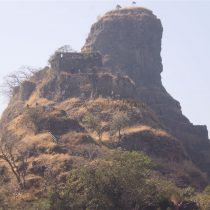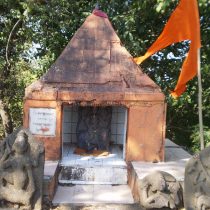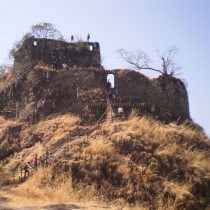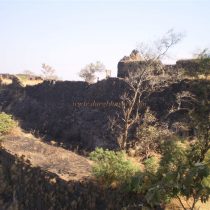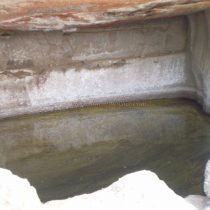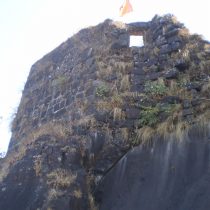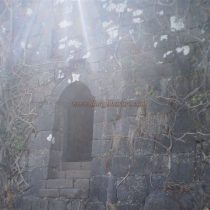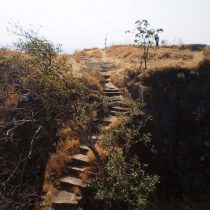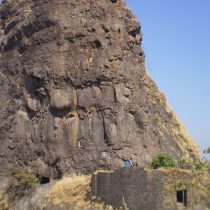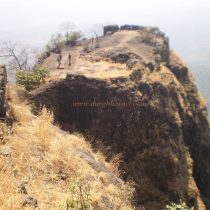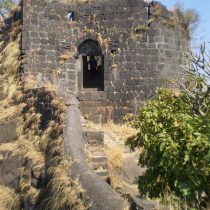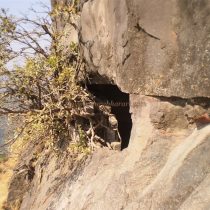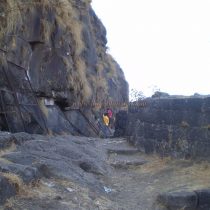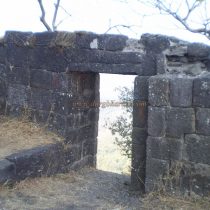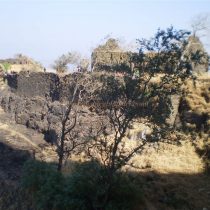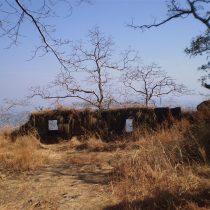KARNALA
TYPE : HILL FORT
DISTRICT : RAIGAD
HEIGHT : 1300 FEET
GRADE : MEDIUM
On the way from Mumbai to Konkan or Pune, after crossing the city of Panvel, the thumb-shaped Karnala fort is well known to most people. To reach this fort near Shirdhon village in Raigad district, you have to reach the bird sanctuary at the base of the fort in front of Shirdhon village. The dense forest at the base of the fort is a bird sanctuary and more than one hundred and fifty different species of birds are found in this forest. As the fort is in the possession of the Forest Department, an entrance fee is charged for visiting the fort. The path to the fort is visible and the climb is steep and tiring. The hill we climb on and the hill of Karnala fort are connected by a trunk. Within an hour, we reach the plateau below the fort. The fort is divided into two parts, Machi and the citadel.
...
The citadel is a 100 feet high pinnacle. On the plateau below the gate of the fort is a domed temple of Goddess Karnai with a black stone idol of the goddess. There are some carvings outside the temple. We enter the fort by crossing the first gate that descends from the plateau. There are steps carved in the rock to go up to the next part of the fort. Iron fences have been built on these steps for protection. We reach the second gate of the fort by climbing the iron ladder at the front of the road. There is a third gate of the fort at some distance in front of this second gate and after entering through this gate we enter the fort. The head of the fort is spread from south to north and the ramparts on it have collapsed to a great extent. In front of the door is the temple of Bhavani Mata and next to it is a structure build-out of wrought stone. This structure is still standing along with its walls. A Shivling is kept open at some distance in front of the mansion. There is a pinnacle about 100 feet high in front and a large number of beehives can be seen on this pinnacle. To climb this pinnacle, one needs to have mountaineering equipment, as well as one, needs to be familiar with rock climbing techniques. At the base of this pinnacle are large water cisterns and caves carved into the rock. The ramparts of the fort can be seen around the pinnacle. After taking a detour and going to the backside of the pinnacle, you can see another small hill connected to the hill of the fort by a small trunk. This western part of the fort has some plain area and most of the remains here are in a good condition. There are two doors in this area and outside one of the doors, there are carvings on both sides. Considering the overall structure of the fort and its geographical location, it should be used mainly for surveillance of the surrounding area. There are two inscriptions in Persian and one in Marathi on the fort. In the Persian inscription, it is written as ‘Sayyid Nuruddin Muhammad Khan, Hijri 1146’ (1735 AD). On the Marathi inscription, there is a sentence 'शके १५९२ संवत्सर आषाढ शुद्ध १४ मालुजी गंभीरराव ठाणदार कर्नाळा घेतला'. From the top of the fort, Panvel city and Manikgad to the west, the Sahyadri range spread to the west, the Sankashi fort to the north, and Matheran to the northwest. One hour is enough to see the entire fort. Looking at the water cisterns on the fort, Karnala fort must have existed since ancient times. In medieval times, the Karnala fort was used to control the commercial traffic from Panvel to Mumbai and from Chaul port from BorGhat. History does not mention exactly who built the Karnala fort, but from 1248 to 1318, Karnala was ruled by Devagiri Yadavs. Between 1318 and 1347, this fort came under the control of Bahmani and then to the Nizamshahi. During this period Karnala was the headquarters of North Konkan i.e. Thane and Raigad. The Sultan of Gujarat, with the help of the Portuguese, captured the fort of Karnala from the Nizamshah. The captain of Vasai broke through the siege of the Nizam's army and conquered the fort and deployed 300 European troops to protect the fort. Later, as a result of the friendship between the Portuguese and the Nizam, the Portuguese handed over the fort to the Nizam Shah for a fixed ransom of 1750 pounds per annum. After the fall of Nizamshahi, this part of Konkan came under the control of the Mughals but in return for some annual ransom, the Mughals gave this part to Adilshah. In 1657, Chhatrapati Shivaji Maharaj annexed this fort into Swarajya from the Adilshah. The Karnala fort was one of the twenty-three forts given to the Mughals in the treaty of Purandar. In 1670, the Maratha army besieged the fort. By making mud barriers, Maratha’s gradually moved forward and reached the base of the fort. After reaching the base of the fort, the Maratha army entered the fort with the help of ropes given the shape of ladders and captured Karnala fort. Later, during the reign of Sambhaji Maharaj, the Mughals regained control of the fort. When the fort came under the control of the Marathas in 1740, the Peshwas appointed Anantrao Phadke as their fort keeper. Anantrao Phadke is the grandfather of the revolutionary Vasudev Balwant Phadke. In 1803, the fort was captured by the British on behalf of Bajirao II. When General Prother captured Karnala in 1818, the soldiers on Karnala fort fought the British for three days. The pinnacle of Karnala ignited the spark of freedom in the mind of the early revolutionary Vasudev Balwant Phadke. Durga Maharshi GN Dandekar's novel ‘Jait Re Jait’ has got the background of Karnala fort and the Marathi film ‘Jait Re Jait’ has been shot in this area. If you stay in Mumbai, Pune, or Thane, you can easily visit Karnala Fort and Bird Sanctuary in one day.
© Suresh Nimbalkar

